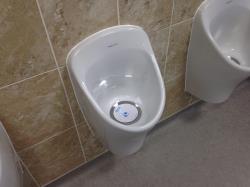
14 February 2019 | Commercial Washrooms
The Pros & Cons of Waterless Urinals
Before you decide on which urinal system to go with, take a look at the pros and cons of waterless urinals. They might just be the best choice for your business…
Traditionally, urinals and troughs are flushed regularly on a timer. While this quick rinse prevents bacteria and smells from lingering, it also means pouring water down the drain even when the urinals haven’t been used.Over the course of a year, this can be costly in both water and sewerage charges, particularly at a big site. The installation of waterless urinals can help combat this and be hugely beneficial to your business. Here’s why… Armitage Shanks waterless urinal Easy installation Waterless urinals do not require a mains water feed.
A cartridge is fitted in the waste outlet, which works to trap smells coming up the waste pipe and keeps the urinal smelling fresh. This means you only need to fit waste pipes to the urinal, keeping washrooms free from exposed pipework without the need for ducting sets or chasing. Great for exposed and outdoor washrooms.
For washrooms that are exposed to the elements or in poorly insulated outbuildings, waterless urinals could be a sensible move. With no mains water feed to worry about, there is no risk of the pipes freezing up, so no pipe lagging or other insulation measures are needed to prevent iced up pipes. Improved hygiene When traditional urinals have been flushed, there is a moist, damp surface left behind which is the ideal breeding ground for bacteria.
Waterless urinals have a much drier surface and providing they are cleaned regularly to the manufacturer's specific instructions (usually just a spray) they can improve hygiene significantly. Less maintenance With no mains water to worry about, there is a reduced risk or accidental damage and flooding in your washroom.
With routine checks for Legionella made much easier, you can enjoy a lighter load when it comes to washroom maintenance. Considerations for extremely high traffic environments However, despite all the great benefits of waterless urinals, in extremely high traffic locations such as motorway service areas, train stations and airports, it can sometimes be advantageous to have a mains water flushed urinal.
That said, there are many sites that experience huge footfall that have still made the switch to waterless urinals. The next point may have been a heavy factor in that decision… The financial savings By the very nature of a waterless urinal system, you cut out the need for mains water, which also impacts your washrooms sewerage charges.
Collectively this can have a significant impact on running costs and finances. Each urinal is estimated to deliver a saving on these costs by around £400 per year. Across a busy site, this can be an impressive gross saving. The environmentally friendly move to waterless urinals has a lot of benefits to both operational costs and installation.
The replaceable cartridges have a life of 15,000-20,000 uses, and conversion kits are available so that you can retrofit them into your existing sanitaryware. As always, our team are at the end of the telephone for all your queries and questions and have a wealth of knowledge they’re happy to share with you.
So if you need some guidance, or would like to talk over your options, you can give them a call on 01202 650900. Got a question? Get in touch